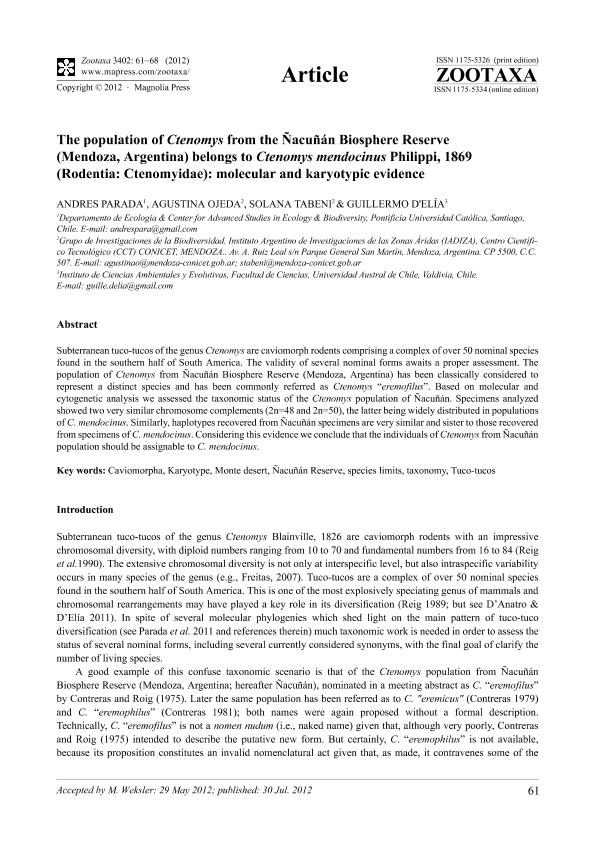Artículo
The population of Ctenomys from the Ñacuñán Biosphere Reserve (Mendoza, Argentina) belongs to Ctenomys mendocinus Philippi, 1869 (Rodentia, Ctenomyidae): molecular and karyotypic evidence
Fecha de publicación:
05/2012
Editorial:
Magnolia Press
Revista:
Zootaxa
ISSN:
1175-5326
e-ISSN:
1175-5334
Idioma:
Inglés
Tipo de recurso:
Artículo publicado
Clasificación temática:
Resumen
Subterranean tuco-tucos of the genus Ctenomys are caviomorph rodents comprising a complex of over 50 nominal species found in the southern half of South America. The validity of several nominal forms awaits a proper assessment. The population of Ctenomys from Ñacuñán Biosphere Reserve (Mendoza, Argentina) has been classically considered to represent a distinct species and has been commonly referred as Ctenomys eremofilus. Based on molecular and cytogenetic analysis we assessed the taxonomic status of the Ctenomys population of Ñacuñán. Specimens analyzed showed two very similar chromosome complements (2n=48 and 2n=50), the latter being widely distributed in populations of C. mendocinus. Similarly, haplotypes recovered from Ñacuñán specimens are very similar and sister to those recovered from specimens of C. mendocinus. Considering this evidence we conclude that the individuals of Ctenomys from Ñacuñán population should be assignable to C. mendocinus.
Palabras clave:
Caviomorpha
,
Karyotype
,
Monte Desert
,
Ñacuñán Reserve
Archivos asociados
Licencia
Identificadores
Colecciones
Articulos(IADIZA)
Articulos de INST. ARG DE INVEST. DE LAS ZONAS ARIDAS
Articulos de INST. ARG DE INVEST. DE LAS ZONAS ARIDAS
Citación
Parada, Andrés; Ojeda, Agustina Alejandra; Tabeni, Maria Solana; D'Elia, Guillermo; The population of Ctenomys from the Ñacuñán Biosphere Reserve (Mendoza, Argentina) belongs to Ctenomys mendocinus Philippi, 1869 (Rodentia, Ctenomyidae): molecular and karyotypic evidence; Magnolia Press; Zootaxa; 3402; 5-2012; 61-68
Compartir




